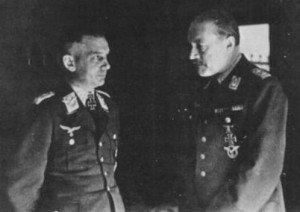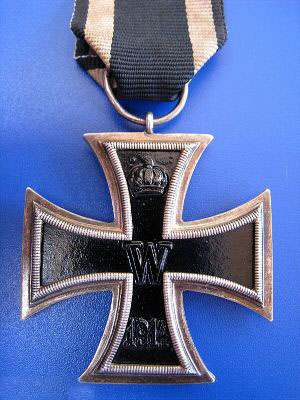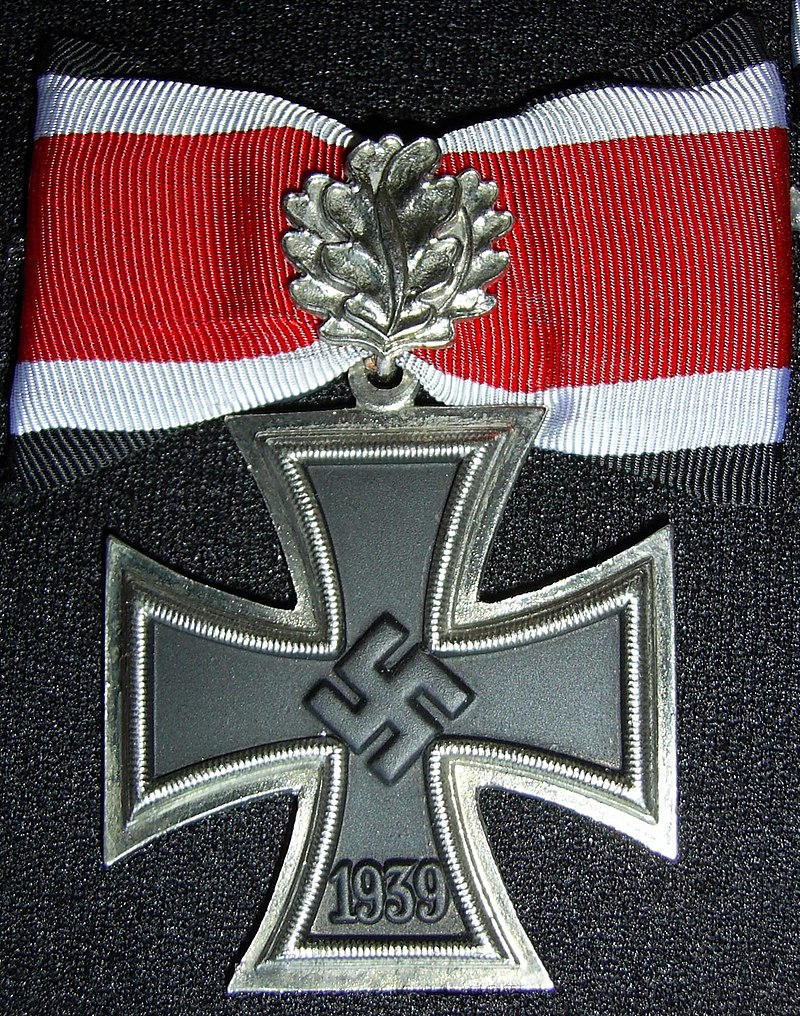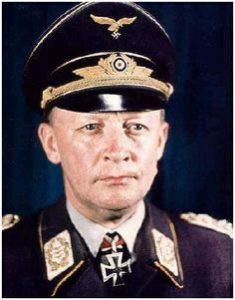Student, Kurt Arthur Benno “Papa”, born 12-05-1890 into an upper middle class German family in the city of Birkholz.  His father was a landowner, and he had three brothers. Soon after Student’s birth, things did not go well for Father Student, and eventually, after the young death of his mother, the money for education would not be available. It is for this reason that Kurt, who is just eleven years old, is sent to a military boarding school. A path and a motivation that will prove to be an appropriate path for many later well-known German high officers. From eleven to seventeen, this young Prussian, originally from Neumark, in Brandenburg, undergoes the hard training of the Imperial Cadet School in Potsdam, then in Lichterfelde near Berlin. Kurt hoped to be a doctor, but his family could not afford the education needed. Student’s mother died when he was 11. His father sent him to the Royal Prussian Cadet School in Potsdam
His father was a landowner, and he had three brothers. Soon after Student’s birth, things did not go well for Father Student, and eventually, after the young death of his mother, the money for education would not be available. It is for this reason that Kurt, who is just eleven years old, is sent to a military boarding school. A path and a motivation that will prove to be an appropriate path for many later well-known German high officers. From eleven to seventeen, this young Prussian, originally from Neumark, in Brandenburg, undergoes the hard training of the Imperial Cadet School in Potsdam, then in Lichterfelde near Berlin. Kurt hoped to be a doctor, but his family could not afford the education needed. Student’s mother died when he was 11. His father sent him to the Royal Prussian Cadet School in Potsdam  in 1901, where he could train for a career in the military. Commander-in-Chief of the Reichswehr was Kurt von Hammerstein-Equord.
in 1901, where he could train for a career in the military. Commander-in-Chief of the Reichswehr was Kurt von Hammerstein-Equord. 
 The school emphasized strict discipline, sports, and loyalty to the emperor and nation. Student did well in school, except in mathematics. Upon graduating in 1911, he became a lieutenant in the Imperial German Army. In 1913, he trained to be a pilot in the army air force. After serving initially with a light infantry (Jäger) battalion, he underwent pilot training in 1913. He received his commission in 1913, and was transferred into what was to become Goering’s (see Hermann Goering) (did you know) Luftwaffe
The school emphasized strict discipline, sports, and loyalty to the emperor and nation. Student did well in school, except in mathematics. Upon graduating in 1911, he became a lieutenant in the Imperial German Army. In 1913, he trained to be a pilot in the army air force. After serving initially with a light infantry (Jäger) battalion, he underwent pilot training in 1913. He received his commission in 1913, and was transferred into what was to become Goering’s (see Hermann Goering) (did you know) Luftwaffe  , but was then called the German Army Air Service. During the first war, he served as a reconnaissance pilot and he flew bombers. He became the commander of Fighter Group 9, nicknamed “Jasta” on 01-09-1916, with the new Fokker D, two wings airplanes.
, but was then called the German Army Air Service. During the first war, he served as a reconnaissance pilot and he flew bombers. He became the commander of Fighter Group 9, nicknamed “Jasta” on 01-09-1916, with the new Fokker D, two wings airplanes.


 Kurt Student was wounded in an air battle with the French Captain Flyer Pinsarde, sustained a shot in the left shoulder, a vein was teared, but he still could bring his plane to the ground. In 1934 and with Hitler now Germany’s leader, Student joined the Luftwaffe. Within Germany, Adolf Hitler (did you know) had made it clear that he wanted to expand this part of Germany’s military. Student, nicknamed by his men as “Papa” played a key role in the development of the Luftwaffe. In keeping with the whole of Generaloberst der Panzertruppe, Heinz Guderian’s
Kurt Student was wounded in an air battle with the French Captain Flyer Pinsarde, sustained a shot in the left shoulder, a vein was teared, but he still could bring his plane to the ground. In 1934 and with Hitler now Germany’s leader, Student joined the Luftwaffe. Within Germany, Adolf Hitler (did you know) had made it clear that he wanted to expand this part of Germany’s military. Student, nicknamed by his men as “Papa” played a key role in the development of the Luftwaffe. In keeping with the whole of Generaloberst der Panzertruppe, Heinz Guderian’s  Blitzkrieg philosophy, Student was ordered to form Germany’s first ever parachute battalion in 1938. His assistant was the young then Oberleutnant der Flieger, Hans Jeschonnek.
Blitzkrieg philosophy, Student was ordered to form Germany’s first ever parachute battalion in 1938. His assistant was the young then Oberleutnant der Flieger, Hans Jeschonnek. 
 Such a military unit was almost unheard of, though Soviet Russia had been training parachutists in the Red Army, but it was to play a major part in the whole concept of ‘lightening war’. A parachute training school was raised in Stendal 150 km from Berlin, all further paras were volunteers. Student’s new fighting force was not used in the attack on Poland. In one sense, the overwhelming power of the German military meant that it really was not needed against the Poles. However, the main reason, was Hitler’s desire to keep such a new unit secret until Blitzkrieg was unleashed against Western Europe. German paratroopers were used with success in the campaign in Norway, Belgium and Holland. Student’s para’s under Oberleutnant der Luftwaffe, Walter Koch,
Such a military unit was almost unheard of, though Soviet Russia had been training parachutists in the Red Army, but it was to play a major part in the whole concept of ‘lightening war’. A parachute training school was raised in Stendal 150 km from Berlin, all further paras were volunteers. Student’s new fighting force was not used in the attack on Poland. In one sense, the overwhelming power of the German military meant that it really was not needed against the Poles. However, the main reason, was Hitler’s desire to keep such a new unit secret until Blitzkrieg was unleashed against Western Europe. German paratroopers were used with success in the campaign in Norway, Belgium and Holland. Student’s para’s under Oberleutnant der Luftwaffe, Walter Koch, captured the famous fortress of Eben Email,
captured the famous fortress of Eben Email, landing with six gliders on the unprotected top of the fortress, the Begian forces rapidly surrendered. In Rotterdam, Holland, Student, sticken his head out of a window, was mistakenly shot in the head by a German para sniper of the SS Leibstandarte, but survived. He was taken to the already by bombs damaged hospital in Rotterdam and he had his skull pressed in and the brain lobe was leaking, but he still was conscious and partly paralysed. After several operations by the 36 years old Dutch brain specialist, doctor Cornelis van Staveren, who had hesitated only one second when he saw that a “German” General was the wounded,
landing with six gliders on the unprotected top of the fortress, the Begian forces rapidly surrendered. In Rotterdam, Holland, Student, sticken his head out of a window, was mistakenly shot in the head by a German para sniper of the SS Leibstandarte, but survived. He was taken to the already by bombs damaged hospital in Rotterdam and he had his skull pressed in and the brain lobe was leaking, but he still was conscious and partly paralysed. After several operations by the 36 years old Dutch brain specialist, doctor Cornelis van Staveren, who had hesitated only one second when he saw that a “German” General was the wounded, and in Berlin by the famous professor Wilhelm Tönnis
and in Berlin by the famous professor Wilhelm Tönnis 
 . Tönnis died old age 80 on 12-09-1978, in Dortmund and Van Staveren died in his hometown Rotterdam at the very old age of 93 on 15-03-1997, and a grateful Student said to him: “Sie haben mir das Leben gerettet” you saved my life. Student did not return to duty until January 1941, more then 8 months. In particular, the parachutist attack on Rotterdam all but took the heart out of the Dutch defense, (see Jan Ackermans) such was its speed and ferocity The input of Student’s parachutists in the various attacks on Western Europe had done a lot to convince Hitler that they were an important aspect of his military. In May 1941, they were used in the attack on Crete, Operation Merkur (see Blücher brothers)
. Tönnis died old age 80 on 12-09-1978, in Dortmund and Van Staveren died in his hometown Rotterdam at the very old age of 93 on 15-03-1997, and a grateful Student said to him: “Sie haben mir das Leben gerettet” you saved my life. Student did not return to duty until January 1941, more then 8 months. In particular, the parachutist attack on Rotterdam all but took the heart out of the Dutch defense, (see Jan Ackermans) such was its speed and ferocity The input of Student’s parachutists in the various attacks on Western Europe had done a lot to convince Hitler that they were an important aspect of his military. In May 1941, they were used in the attack on Crete, Operation Merkur (see Blücher brothers)  under Generalmajor Bruno Bräuer.
under Generalmajor Bruno Bräuer. Student was thrilled at being able to plan the operation against Crete because an airborne assault of this size, without the use of ground forces, had never before been attempted. On May 7, Student flew to Athens where he learned that Goering had given overall command of Mercury to General Alexander Lohr.
Student was thrilled at being able to plan the operation against Crete because an airborne assault of this size, without the use of ground forces, had never before been attempted. On May 7, Student flew to Athens where he learned that Goering had given overall command of Mercury to General Alexander Lohr. 
 Under Lohr, Student and General Wolfram von Richtofen
Under Lohr, Student and General Wolfram von Richtofen  had to share command of the VIII Fliegerkorps.
had to share command of the VIII Fliegerkorps.Student’s as Kommandeur der 1st Fallschirmjäger Regiment,
 8000 parachutists, in 500 Junkers (see Junkers), suffered heavy losses despite their ultimate victory on the Mediterranean island. Other Crete commanders were, General der Panzertruppe, Kommandeur General II FS Korps, Eugen Meindl and Walter Koch
8000 parachutists, in 500 Junkers (see Junkers), suffered heavy losses despite their ultimate victory on the Mediterranean island. Other Crete commanders were, General der Panzertruppe, Kommandeur General II FS Korps, Eugen Meindl and Walter Koch
 . Despite their actual success in Crete against the British, New Zealand and Australians forces under General Bernard Freyberg, Hitler was shocked by the number of men of Student´s and General Eugen Meindl’s
. Despite their actual success in Crete against the British, New Zealand and Australians forces under General Bernard Freyberg, Hitler was shocked by the number of men of Student´s and General Eugen Meindl’s  men killed in action and he ordered a halt to their use in future large-scale in any military operations.
men killed in action and he ordered a halt to their use in future large-scale in any military operations.
 Both sides paid a high price in the battle for Crete. The British and Empire forces tallied 1.472 dead, 1.737 wounded, and 11.835 prisoners. The British fleet lost many ships and there were 1,828 dead among their crews. The Germans totaled 3.352 dead, including 1.653 paratroopers, and 3.346 wounded. and 151 Junkers were destroyed. As a result of this order, Student’s men were denied the opportunity for any more large scale raid by parachute. After D-Day, the 1st Parachute Regiment was used in an attempt to halt Bernard Montgomery’s advance to the Rhine, but it was action on the ground.
Both sides paid a high price in the battle for Crete. The British and Empire forces tallied 1.472 dead, 1.737 wounded, and 11.835 prisoners. The British fleet lost many ships and there were 1,828 dead among their crews. The Germans totaled 3.352 dead, including 1.653 paratroopers, and 3.346 wounded. and 151 Junkers were destroyed. As a result of this order, Student’s men were denied the opportunity for any more large scale raid by parachute. After D-Day, the 1st Parachute Regiment was used in an attempt to halt Bernard Montgomery’s advance to the Rhine, but it was action on the ground.
 Such was the Allies command of the air, that any chance of a large scale attack by German parachutists was effectively gone, though it was still forbidden by Hitler. General Kurt Student had a distinguished military career. Kurt Student was involved in the attack on Western Europe in 1940, the planning for Operation Sealion and in the largest German airborne attack in the war, the attack on Crete with Bruno Bräuer.
Such was the Allies command of the air, that any chance of a large scale attack by German parachutists was effectively gone, though it was still forbidden by Hitler. General Kurt Student had a distinguished military career. Kurt Student was involved in the attack on Western Europe in 1940, the planning for Operation Sealion and in the largest German airborne attack in the war, the attack on Crete with Bruno Bräuer. 
 He was also present in the Operation “Wacht am Rhein”, later changed in Operation “Herbstnebel”, the Ardenne Offensive but as these failt Jodl said that one of the Generals who didn´t had done his duty was Student, but Hitler let down this allegation. Later when Student joked with the failing German artillery, the men in Hitler´s headquarters
He was also present in the Operation “Wacht am Rhein”, later changed in Operation “Herbstnebel”, the Ardenne Offensive but as these failt Jodl said that one of the Generals who didn´t had done his duty was Student, but Hitler let down this allegation. Later when Student joked with the failing German artillery, the men in Hitler´s headquarters  , who disliked him, laughable talked about Student´s slow way of talking, which he did after the wounds in Rotterdam and he was replaced by Generaloberst der Infanterie, Oberbefehlhaber Heeresgruppe G, Johannes Blaskowitz.
, who disliked him, laughable talked about Student´s slow way of talking, which he did after the wounds in Rotterdam and he was replaced by Generaloberst der Infanterie, Oberbefehlhaber Heeresgruppe G, Johannes Blaskowitz. 
 When Generaloberst der Panzertruppe, command of the 1st Panzerarmee Army Group Vistula, Gotthard ” Our poison Dwarf” Heinrici couldn´t resque Berlin in April 1945 he was released and Student immediately had to fly to Mecklenburg to stabilize the defence. This was not so easy as it was almost impossible for German planes to airborne at that time. Arriving at the airport they were shot from all sides and they just had enough fuel to reach Lübeck in the north. There Student, age 55, was soon captured by the quick advancing British forces. Kurt Student was put on trial in May 1946 for war crimes committed in Greece and Crete and remained in prison for three years. On June 3, 1941, a day after executing several civilians in Kondomari , German troops from the III Battalion of the 1st Air Landing Assault Regiment (most probably led by Oberleutnant Horst Trebes
When Generaloberst der Panzertruppe, command of the 1st Panzerarmee Army Group Vistula, Gotthard ” Our poison Dwarf” Heinrici couldn´t resque Berlin in April 1945 he was released and Student immediately had to fly to Mecklenburg to stabilize the defence. This was not so easy as it was almost impossible for German planes to airborne at that time. Arriving at the airport they were shot from all sides and they just had enough fuel to reach Lübeck in the north. There Student, age 55, was soon captured by the quick advancing British forces. Kurt Student was put on trial in May 1946 for war crimes committed in Greece and Crete and remained in prison for three years. On June 3, 1941, a day after executing several civilians in Kondomari , German troops from the III Battalion of the 1st Air Landing Assault Regiment (most probably led by Oberleutnant Horst Trebes 
 here with General Wilhelm Falley
here with General Wilhelm Falley  Falley, Kommandeur der 91 st Infanterie Division. 1st killed General on D-Day, by Malcolm Brannen
Falley, Kommandeur der 91 st Infanterie Division. 1st killed General on D-Day, by Malcolm Brannen

 of the 82nd Airborne Division who died 10-03-1999, aged 88 and Generalfeldmarschall Erwin Rommel,
of the 82nd Airborne Division who died 10-03-1999, aged 88 and Generalfeldmarschall Erwin Rommel,  reached Kandanos, following Student’s order for reprisals. The Germans killed about 180 residents and slaughtered all livestock; all houses were torched and razed. Nearby villages such as Floria and Kakopetro met a similar fate. After its destruction, Kandanos was declared a ‘dead zone’ and its remaining population was forbidden to return to the village and rebuild it. Horst Trebes was killed in battle during the fighting in the hedgerows and break out of the Allied armies through Saint-Lo on 29-07-1944 (aged 27).
reached Kandanos, following Student’s order for reprisals. The Germans killed about 180 residents and slaughtered all livestock; all houses were torched and razed. Nearby villages such as Floria and Kakopetro met a similar fate. After its destruction, Kandanos was declared a ‘dead zone’ and its remaining population was forbidden to return to the village and rebuild it. Horst Trebes was killed in battle during the fighting in the hedgerows and break out of the Allied armies through Saint-Lo on 29-07-1944 (aged 27).


 Student’s only son lieutenant Hans Dietrich, with his wife Gertrud, born Beer, born 04-04-1892 and died 21-05- 1978 (age 86.), an air fighter with the I. Gruppe/JG 77
Student’s only son lieutenant Hans Dietrich, with his wife Gertrud, born Beer, born 04-04-1892 and died 21-05- 1978 (age 86.), an air fighter with the I. Gruppe/JG 77  , age 20, crashed with his Messerschmitt Bf 109 F-4-Trop
, age 20, crashed with his Messerschmitt Bf 109 F-4-Trop in Holland, near Arnhem “Bridge too far”, on 28-09-1944 during Operation Market Garden, (see About) (see Walter Model)
in Holland, near Arnhem “Bridge too far”, on 28-09-1944 during Operation Market Garden, (see About) (see Walter Model)  (see Wilhelm Bittrich)
(see Wilhelm Bittrich)  (see Hans Peter Knaust)
(see Hans Peter Knaust)  . He died later in the Reserve Lazarett, Dorsten. Hans Dietrich was buried on the war cemetery of Stahnsdorf, grave 90.
. He died later in the Reserve Lazarett, Dorsten. Hans Dietrich was buried on the war cemetery of Stahnsdorf, grave 90.Death and burial ground of Student, Kurt Arthur Benno “Papa”.

 Student was known for his energy, intelligence, precision, and drive. Student had few interests outside of his career and hunting. Kurt Student died old age 88, on 01-07-1978 in Bad Salzuflen and is buried with his son and wife Gertrud, born Beer, who died old age 86, on 21-05-1978, on the Stadtfriedhof of Bad Salzuflen.
Student was known for his energy, intelligence, precision, and drive. Student had few interests outside of his career and hunting. Kurt Student died old age 88, on 01-07-1978 in Bad Salzuflen and is buried with his son and wife Gertrud, born Beer, who died old age 86, on 21-05-1978, on the Stadtfriedhof of Bad Salzuflen.























Leave a Reply